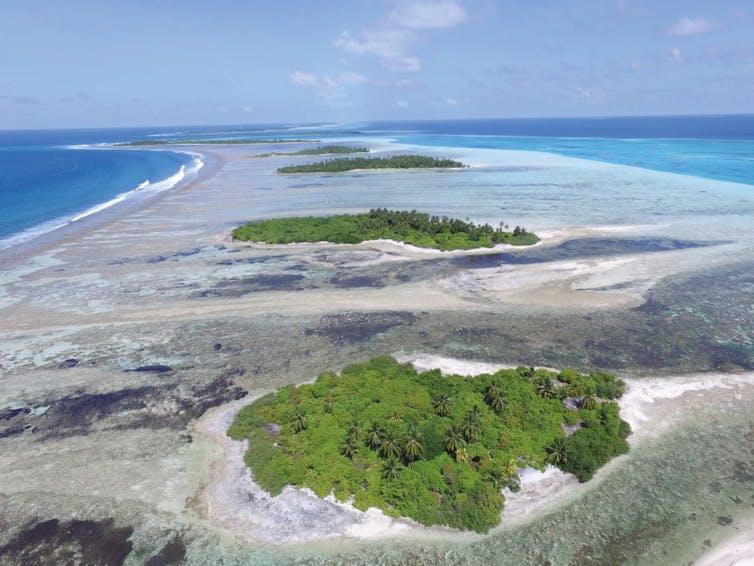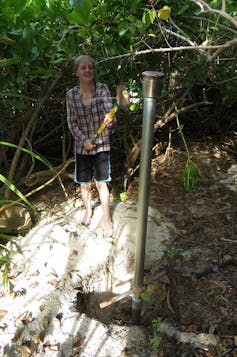At the southern tip of the Maldives, on the tiny island of Villingili, a patch of ground rises to tower a whole 2.4m above the sea. It’s the world’s lowest high point.
With most islands just a metre or so above the sea level, it is often suggested that the world’s lowest country may drown beneath rising sea levels by the end of the century. For tourists, this ranks the Maldives atop bucket lists of destinations to visit before they disappear. For the 400,000 people who live on the islands, things are rather more serious: rising sea levels could render them climate change refugees.
However, such scenarios of inundation and drowning assume that the land surface remains static and unchanged. But, what if the land could build vertically as sea level rises?
This is what colleagues and I have been examining in our research, now published in Geophysical Research Letters. We studied five reef islands in the southern Maldives and found that they were actually built when sea levels were higher than they are today.

The Maldives is a nation of around 1,200 coral reef islands. Reef islands are unique landforms in that they are formed entirely of sediments produced by organisms such as corals, molluscs and gastropods that live on coral reefs in the surrounding waters.
However, this reliance on the coral reef for island-building sediments, combined with elevations rarely more than a few metres above the sea, means that reef islands are often considered among the most vulnerable environments to climate change, particularly to sea level rise. This is of particular concern for nations such as the Maldives that are built entirely on reef islands, and have nowhere else to go.
Read more: Venice flooding is getting worse – and the city's grand plan won't save it
Back to the future
To improve predictions of how reef islands may respond to future environmental change, it is important to understand how they responded to environmental change in the past. To this end, we reconstructed the island-building histories of five islands in the southern Maldives.

We first collected 28 reef island “cores”. This essentially involved sledgehammering an aluminium pipe into the reef island until it reached the island “foundations” – a point lower than the live coral in the surrounding ocean. The cores enabled us to access the layers of sediment that have built up throughout the island’s history. We then analysed these sediments under the microscope to find out what exactly the island is made of. In addition, we radiocarbon dated the sediments to determine the when the various layers were created.
Results showed that the key phase of reef island building occurred between 4,200 and 1,600 years ago, when sea levels reached around 0.5m higher than they are today.
In addition, this was likely under the influence of large wave events caused by distant storms. These waves would have had the power to break pieces of coral off the reef. Over time, these pieces of coral, as well as sand from the the reef, built up to form the islands.
Climate change will mean rising sea levels and even stronger large wave events. It may therefore recreate conditions that are conducive to reef island building, which may enable these islands to keep growing vertically.

This would make the islands more resilient and may even be necessary simply to keep pace with rising sea levels. Our work complements other studies which are showing that islands are in fact dynamic landforms that are able to move and adjust in response to environmental change.
So is this good news for the Maldives?
All this should make reef islands in the Maldives more physically resilient. However, large waves can also make islands less habitable for humans, for instance by damaging buildings and farmland, or by dumping salt into supplies of fresh water. Reef island nations will have to develop infrastructure that can withstand, or be adaptable to, such powerful waves. Such infrastructure must still allow natural processes to take place however, so that reef islands can maintain active connections to their surrounding coral reefs.
While our study suggests that rising sea levels could benefit reef islands in some regards, they still remain at risk. For instance, we also found the islands in our study were made predominantly (about 75%) of coral. This means a healthy reef will be vital if the islands are to keep growing in future, and the Maldives are to remain above the waves.
However, coral reefs are also threatened by climate change, not just by rising sea levels, but also by warmer and more acidic oceans. Under climate change, we may therefore end up in an odd situation where we have the perfect conditions to build coral reef islands, but an absence of any building materials.

